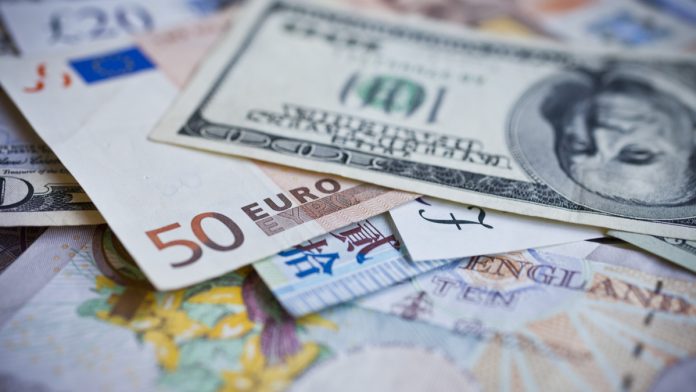The pound had a tough week back after Easter. The pound fell 0.5% versus the dollar across the week, hitting a low of US$1.2865, its weakest level since February 15th. However, the pair closed on Friday up 0.1% despite the US economy showing strong growth, snapping a 9-session losing streak.
| What do these figures mean? |
|---|
| When measuring the value of a pair of currencies, one set equals 1 unit and the other shows the current equivalent. As the market moves, the amount will vary from minute to minute.For example, it could be written:1 GBP = 1.28934 USDHere, £1 is equivalent to approximately $1.29. This specifically measures the pound’s worth against the dollar. If the US dollar amount increases in this pairing, it’s positive for the pound. Or, if you were looking at it the other way around:1 USD = 0.77786 GBPIn this example, $1 is equivalent to approximately £0.78. This measures the US dollar’s worth versus the British pound. If the sterling number gets larger, it’s good news for the dollar. |
News flow over Brexit had been limited around the Easter recess. Headlines started to drip through again last week and they weren’t particularly encouraging. News that Theresa May was staying as Prime Minister offered some stability to the pound. However, reports that cross party Brexit talks between the government and the Labour party have made little progress and could actually stall have weighed on the pound. If not enough common ground is reached between the parties by the end of April there is a chance that the Labour party could call a vote of no confidence. This means a general election could be on the cards, especially given that the European elections are just around the corner on May 22nd. Participation in these elections would highlight Theresa May’s failure to deliver Brexit.
| Why is a “soft” Brexit better for sterling than a “hard” Brexit? |
|---|
| A soft Brexit implies anything less than UK’s complete withdrawal from the EU. For example, it could mean the UK retains some form of membership to the European Union single market in exchange for some free movement of people, i.e. immigration. This is considered more positive than a “hard” Brexit, which is a full severance from the EU. The reason “soft” is considered more pound-friendly is because the economic impact would be lower. If there is less negative impact on the economy, foreign investors will continue to invest in the UK. As investment requires local currency, this increased demand for the pound then boosts its value. |
UK economic data picks up again this week after a quiet previous week. Today investors will be looking at UK consumer confidence figures. Even when there has been strong UK economic data pound traders have shrugged it off, due to overhanging Brexit talks. That said, analysts expect consumer confidence to remain soft.
Later in the week pound traders will glance towards the Bank of England rate decision. The central bank is unlikely to make any significant announcements while Brexit talks continue.
US Inflation in focus
The dollar rallied across the previous week as data showed the US economy to be more resilient than the economies of its peers. Additionally, as investors grew increasingly jittery over the health of other global economies, they brought into the US dollar for its safe have properties.
On Friday, US GDP data showed that the US economy grew much faster than what analysts had been expecting. The US economy grew 3.2% in the first three months of the year, much faster than the 2.0% that analysts had pencilled in. Usually this would boost the dollar. However, delving deeper into the numbers there were some areas of concern. The personal consumption expenditure component of the report was much lower than what analysts had predicted, unnerving investors.
Today the focus will be on US inflation from personal consumption expenditure. A weak reading could see the dollar fall lower. This is because the Federal Reserve are unlikely to consider hiking interest rates if inflation is ticking lower, despite strong economic growth.
| Why do raised interest rates boost a currency’s value? |
|---|
| Interest rates are key to understanding exchange rate movements. Those who have large sums of money to invest want the highest return on their investments. Higher interest rate environments tend to offer higher yields. So, if the interest rate or at least the interest rate expectation of a country is relatively higher compared to another, then it attracts more foreign capital investment. Large corporations and investors need local currency to invest. More local currency used then boosts the demand of that currency, pushing the value higher. |
This publication is provided for general information purposes only and is not intended to cover every aspect of the topics with which it deals. It is not intended to amount to advice on which you should rely. You must obtain professional or specialist advice before taking, or refraining from, any action on the basis of the content in this publication. The information in this publication does not constitute legal, tax or other professional advice from TransferWise Inc., Currency Live or its affiliates. Prior results do not guarantee a similar outcome. We make no representations, warranties or guarantees, whether express or implied, that the content in the publication is accurate, complete or up to date. Consult our risk warning page for more details.
This article was initially published on TransferWise.com from the same author. The content at Currency Live is the sole opinion of the authors and in no way reflects the views of TransferWise Inc.





